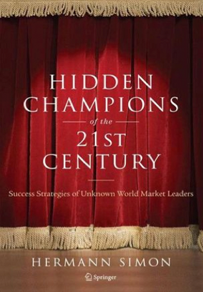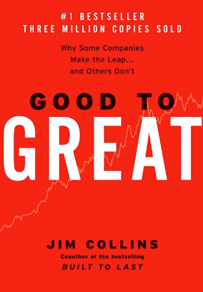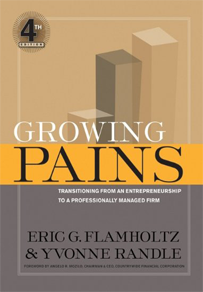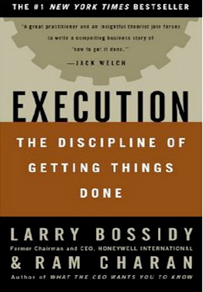Suggested Reading
Browse by Subject
-
Hidden Champions of the Twenty-First Century
Success Strategies of Unknown Market Leaders
by Hermann Simon
Herman Simon defines “Hidden Champions” as medium-sized, unknown companies that have quietly, under the radar, become market leaders in their respective industries. Going inside more than a thousand hidden champions around the world, Simon reveals the common patterns, behaviors, and approaches that make these secretive companies successful by resisting popular management fads, and pursuing such common-sense strategies such as focusing on core capabilities (defining a narrow market), establishing long-term relationships with customers, innovating continuously, build a strong corporate culture, and developing a global presence. The hidden champions represent a clear contrast to the shortsighted practices that have brought many corporate giants crashing down, and prove that even management in the 21st Century should be based on healthy common sense.
-
Moneyball
The Art of Winning an Unfair Game
by Michael Lewis
Most businesses measure the wrong things. Traditional financial statements tell something about where the business has been but they don’t reveal very much about the “why” or give much of an idea about where the business is going. Using his masterful storytelling skills, Lewis tells a captivating story of how one baseball team used data to become one of the most successful teams of its era, despite having the lowest payroll. “Moneyball” delivers an urgent business lesson about moving beyond the way things have always been done and challenging the conventions of your profession, your industry, and your own way of thinking—to find new ways to succeed. “Moneyball” is a good sports book, but an outstanding business book.
-
Good to Great
Why Some Companies Make the Leap…and Others Don’t
by Jim Collins
In what Collins calls a prequel to the bestseller Built to Last he wrote with Jerry Porras, “Good to Great” explores how good or even mediocre companies can be turned into ones that achieve long-term superior performance. To find the keys to greatness, Collins and his team identified 11 companies that made the leap from Good To Great and discovered the characteristics of greatness—why some companies make the leap and their industry counterparts don't. Collins introduces concepts such as Level 5 Leaders, The Hedgehog Concept, A Culture of Discipline, Technology Accelerators, and The Flywheel and the Doom Loop. The findings provide valuable insight to anyone building a company with the potential to become great and enduring. While some of the findings may be counterintuitive, most are simple and common sense. “Good to Great” doesn’t hold all the secrets to success but it is smart, thought-provoking, compelling and tackles big questions.
-
Growing Pains
Transitioning From an Entrepreneurship to a Professionally Managed Firm
by Eric Flamholtz and Yvonne Randle
The overarching topic of Growing Pains is how small entrepreneurial firms make the transition to a professionally managed firm. The authors identify and discuss six organizational development areas that play a deciding role in the successful growth of a business. Flamholtz and Randle use these developmental areas to isolate what must be done during seven stages of organizational growth. Growing Pains also describes a set of organizational growing pains that commonly arise when organizations struggle to manage their growth.
-
Topgrading
How Leading Companies Win by Hiring, Coaching and Keeping the Best People
by Bradford Smart
Great companies don't just depend on strategies—they depend on people. But, half of all employment decisions result in a mis-hire: The wrong person ends up in the wrong job. Any mis-hire can be damaging and a key mis-hire can be disastrous. The Topgrading concept is designed to make certain that you have the very best opportunity to add 'A Players' to your team and avoid the high cost of mistakes.Topgrading works for companies large and small in any industry. Dr. Smart spells out his practical approach to finding and managing A-level talent, as well as coaching B players to turn them into A players. The best businesses have clear expectations about what level of talent is acceptable and what isn’t. This book is a tremendous guide if you are serious about evaluating and developing talent.
-
Execution
The Discipline of Getting things Done
by Larry Bossidy and Ram Charan
A legendary CEO and a top consultant team up to unravel one of the biggest problems in business today: delivering results. Together they've combined their knowledge and experience on how to close the gap between what a company’s leaders want to achieve and actual results. The discipline of execution is an understanding of how to link together people, strategy, and operations, the three core processes of every business. Making these processes work together is the real job of running a business, not formulating a "vision" and leaving the work of carrying it out to others. Execution is a very important reminder that in the end business is about results and the only way you produce results is by executing. It's not rocket science, but on the other hand a lot of business isn't rocket science.
-
The Five Dysfunctions of a Team
A Leadership Fable
by Patrick Lencioni
In The Five Dysfunctions of a Team, Patrick Lencioni offers a leadership fable that is thought-provoking and instructive. Throughout the story, Lencioni reveals the five dysfunctions, which go to the very heart of why teams, even the best ones, often struggle: absence of trust, fear of conflict, lack of commitment, avoidance of accountability, and inattention to results. He outlines a powerful model and actionable steps that can be used to overcome these common hurdles and build a cohesive, effective team. Every manager or executive will recognize the situations described in this book. Just as with his other works, Lencioni has written a practical and compelling story with a deceptively simple message that has become a must-read guide on how to build and manage successful teams.
-
Necessary Endings
The Employees, Businesses, And Relationships That All of Us Have to Give Up in Order to Move Forward
by Dr. Henry Cloud
One of the most important abilities a leader can have is knowing when and how to let go when something, or someone isn’t working—an employee, a business relationship, a sacred cow, a losing product or service, a set of assumptions, a poor business model, or even an entire business. Letting go is essential for business success. Getting to the next level in business always requires ending something you are doing today, leaving it behind, and moving on. Necessary Endings gives readers the tools they need to confront the brutal facts, say good-bye to what’s not working and move on.
-
Leading Change
by John Kotter
In Leading Change, John Kotter provides an excellent roadmap for all leaders trying to orchestrate change throughout their organizations. He identifies the most common mistakes leaders and managers make in attempting to create change and offers an eight-step process to become adept at change: establishing a greater sense of urgency, creating the guiding coalition, developing a vision, communicating the change vision, empowering others to act, creating short-term wins, consolidating gains and producing even more change, and anchoring new approaches in the culture. By improving their ability to change, organizations can increase their chances for success, both now and in the future. Every business leader can profit from Kotter’s thinking on change.
-
Competing for the Future
Breakthrough Strategies for Seizing Control of Your Industry and Creating Markets of Tomorrow
by Gary Hamel and C K Prahalad
This is one of the best books on strategy. Period. Competing for the Future offers a blueprint for what a company must be doing today if it is to exploit the opportunities of tomorrow. The traditional view of strategy is much too static. Hamel and Prahalad contend that smart organizations are able to reshape their industries, they are able to reinvent things and reconceptualize their industries in ways that create a different future. The traditional view of strategy is almost like a Sun Tzu, Art of War, approach: How do we compete given the conditions of the battlefield? Hamel and Prahalad argue that you should change the rules, change the battlefield, and change the game.












